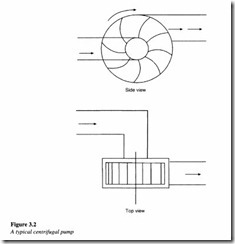Pump classification
Pumps can be broadly listed under two categories:
I. Non-positive displacement pumps and
2. Positive displacement pumps.
Non-positive displacement pumps
They are also known as hydro-dynamic pumps. In these pumps the pressure produced, is proportional to the rotor speed. In other words, the fluid is displaced and transferred using the inertia of the fluid in motion. These pumps are incapable of withstanding high pressures and are generally used for low-pressure and high-volume flow applications. Normally their maximum pressure capacity is limited to 20-30 kgf/cm2. They are primarily used for transporting fluids from one location to the other and find little use in the hydraulic or fluid power industry.
Because of fewer numbers of moving parts, non-positive displacement pumps cost less and operate with little maintenance. They make use of Newton’s first law of motion to move the fluid against the system resistance. Although these pumps provide a smooth and continuous flow, their flow output is reduced as the system resistance (resistance to flow) is increased. In fact it is possible to completely block the outlet to stop all flow even while the pump is running at the designed speed. Thus the pump flow rate depends not only on the rotational speed (rpm) at which it is driven but also on the resistance of the external system. As the resistance of the external system increases, some of the fluid will slip back, causing a reduction in the discharge flow rate. When the resistance of the external system becomes very large, the pump will produce no flow and thus its volumetric efficiency becomes zero. Examples of these pumps are the centrifugal and axial (propeller) pumps.
In a centrifugal pump, a simple sketch of which is illustrated in Figure 3.2, rotational inertia is imparted to the fluid. Centrifugal pumps are not self-priming and must be positioned below the fluid level.
Principle of operation
The fluid from the inlet port enters at the center of the impeller. The rotating impeller imparts centrifugal force to the fluid and causes it to move radially outward. This results in the fluid being forced through the outlet discharge port of the housing. The tips of the impeller blades merely move through the fluid while the rotational speed maintains the fluid pressure corresponding to the centrifugal force established.
Centrifugal pumps are generally used in pumping stations, for delivering water to homes and factories. The advantages of non-positive displacement pumps are:
• Low initial cost and minimum maintenance
• Simplicity of operation and high reliability
• Capable of handling any type of fluid, for example sludge and slurries.
Since the impeller imparts kinetic energy to the fluid, centrifugal pumps are also known as hydrokinetic power generators.
Positive displacement or hydrostatic pumps
As the name implies, these pumps discharge a fixed quantity of oil per revolution of the pump shaft. In other words, they produce flow proportional to their displacement and rotor speed. A majority of the pumps used in fluid power applications belong to this category. These pumps are capable of overcoming the pressure that results from the mechanical loads on the system as well as the resistance to flow due to friction. Thus the pump output flow is constant and not dependent on system pressure. Another advantage associated with these pumps is that the high-pressure and low-pressure areas are separated and hence the fluid cannot leak back and return to the low-pressure source. These features make the positive displacement pump most suited and universally accepted for hydraulic systems.
The advantages of positive displacement pumps over non-positive displacement pumps are:
• Capability to generate high pressures
• High volumetric efficiency
• Small and compact with high power to weight ratio
• Relatively smaller changes in efficiency throughout the pressure range
• Wider operating range i.e. the capability to operate over a wide pressure and speed range.
As discussed earlier, it is important to understand that pumps do not produce pressure; they only produce fluid flow. The resistance to this flow as developed in a hydraulic system is what determines the pressure. If a positive displacement pump has its discharge port open to the atmosphere, then there will be fluid flow, but no discharge pressure above that of atmospheric pressure, because there is no resistance to flow.
If the discharge port is partially blocked, then the pressure will rise due to the resistance to flow. In a scenario where the discharge port of the pump is completely blocked, theoretically an infinite resistance to flow is possible. This will result in a rapid rise in pressure which will result in breakage of the weakest component in the circuit. This is exactly the reason why positive displacement pumps are provided with safety controls, which help prevent the rise in pressure beyond a certain value.
A detailed classification of pumps is shown in Figure 3.3.
